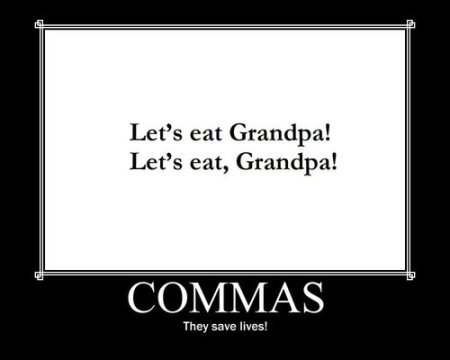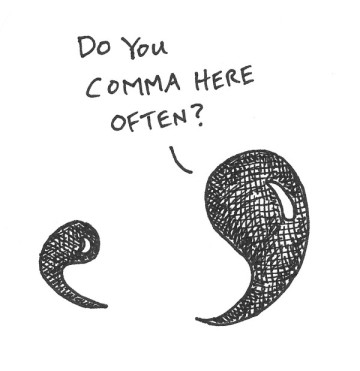
An extremely confusing aspect of grammar and writing is the proper use of the comma. There are many rules for using commas, but they can also be whimsical. A comma may be added when a person feels a pause is necessary in the sentence they are writing. If a different person were to write that same sentence, they may not punctuate the sentence in the exact same way. This aspect of comma usage can make constructing a well punctuated sentence difficult and confusing. The best way to learn how to use commas is to first learn the rules.
Comma rules:
1) Commas can be used to separate items in a series (a series is a list of three or more items). Example: The child got sick on the table, chairs, floor, couch and bed.
2) Commas can be used in between coordinate adjectives (adjectives of equal importance in a sentence. A way to test this is to replace the comma with ‘and’ and the sentence should still make sense.
Example: We spotted an old, grey car. (We spotted an old and grey car)
3) Commas are used to set apart introductory or adverbial phrases
Example: While rushing to meet the deadline, Kevin stumbled and dropped his expensive computer.
4) Use commas to separate nonessential noun clauses from the rest of the sentence
Example: The intelligent man, with very cool glasses, won the award for that year
5) Use commas to separate a compound sentence with two independent clauses
Example: Dylan wrote the book, but Jodi made the movie.
Times when commas should not be used:
1) Commas after a coordinating conjunction
Example: Dylan wrote the book but, Jodi made the movie
2) Before the first item or after the last item in the series
Example: We decided to pack, a tent, flashlight, kettle, sleeping bags, and firewood, for the trip.
3) Commas to separate compound items joined by ‘and’
Example: They decided to pack a tent, and a flashlight for the trip.
4) Commas between a subject and verb, verb and object and preposition and object
Example: The thief was surprised to find in rich businessman’s house, just a few plastic chairs and a sleeping bag.
5) Commas to set apart restrictive elements
Example: The toes, on her right foot, were smushed, during the accident.
6) Commas to join two independent clauses ( comma splice)
Example: I woke up late this morning, I didn’t have time to finish my assignment.
Without the proper use of commas our sentences may become nonsensical or take on a very strange unintended meaning. Some examples of poor comma use:
1) Let’s eat grandpa! ( Please don’t eat your grandpa!)
2) Rachel Ray finds inspiration in cooking her family and her dog (I hope she isn’t inspired by cooking her family and dog)
Although I have set out clear lists for the dos and don’ts of comma use, the comma is also a matter of personal taste. Once there is a clear and basic understanding of the rules it is possible to work within those parameters to create sentences that are grammatically correct and also unique to each person’s voice.

Leave a comment